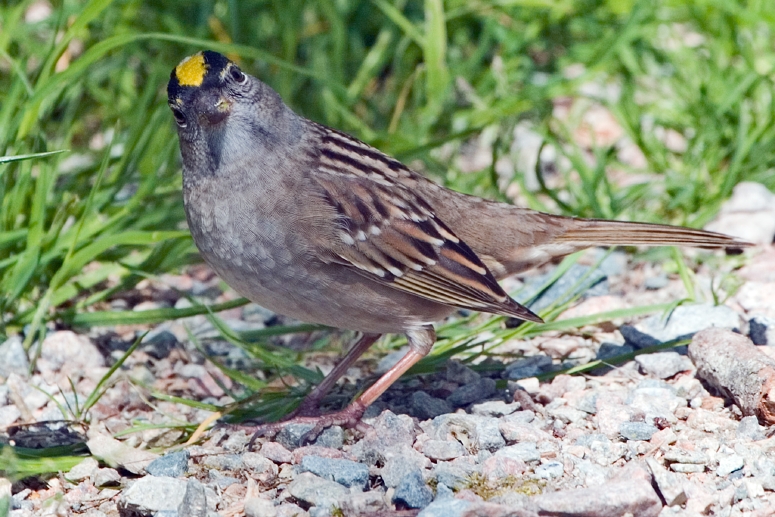- Golden-crowned Sparrow
Taxobox
name = Golden-crowned Sparrow
status = LC | status_system = IUCN3.1

image_width = 250px
regnum =Animal ia
phylum = Chordata
classis = Aves
ordo =Passeriformes
familia = Emberizidae
genus = "Zonotrichia "
species = "Z. atricapilla"
binomial = "Zonotrichia atricapilla"
binomial_authority = (Gmelin, 1789)The Golden-crowned Sparrow, "Zonotrichia atricapilla", is a medium-sized sparrow. It is slightly larger than the closely relatedWhite-crowned Sparrow .Description
Adults are 18 cm (7 in) long. In the breeding season, it has a distinct gold patch on its head, flanked by two dark black stripes. When not breeding, its plumage is more variable, ranging from a small, dull gold patch and no black, to near-breeding season plumage.
Distribution and habitat
The breeding habitat is across the north part of western
Canada and theU.S. state ofAlaska . In the winter the Golden-crowned Sparrow migrates toVancouver Island in Canada and theWest Coast of the United States .Breeding
It nests in shrubby habitat above the treeline or near the coast and lays 3-5 brown-marked greenish white eggs.
ubspecies
No subspecies have been identified.
Behavior
The song is a three-note whistle, descending in pitch. It is very distinctive, and often described as "oh-dear-me". However, birds in the mountains of British Columbia have been reported to have trill on the third note, rather than a clear whistle as in other populations. These songs are heard mainly in the breeding season, but also in the wintering grounds just after fall migration as well as just before they take off for spring migration.
History
Alaskan gold miners along the trails called this bird "Weary Willie", because of its call which sounded like "I'm so weary", (or " 'oh-dear-me' ").
References
* Database entry includes justification for why this species is of least concern
* Byers, Olsson and Curson, "Buntings and Sparrows" ISBN 1-873403-19-4Further reading
Book
* Norment, C. J., P. Hendricks, and R. Santonocito. 1998. "Golden-crowned Sparrow (Zonotrichia atricapilla)". In "The Birds of North America", No. 352 (A. Poole and F. Gill, eds.). The Birds of North America, Inc., Philadelphia, PA.
Thesis
* Lynn K. M.S. (1997). "Multivariate relationships between riparian birds and environmental variables". San Jose State University, United States -- California.
* Turek FW. Ph.D. (1973). "PHOTOPERIODIC PHENOMENA IN WHITE-CROWNED AND GOLDEN-CROWNED SPARROWS (GENUS ZONOTRICHIA)". Stanford University, United States -- California.
Articles
* Campbell RW. (1975). "Golden-Crowned Sparrow Breeding on Vancouver Island". Canadian Field Naturalist. vol 89, no 2. p. 175-176.
* Gorenzel WP, Mastrup SA & Fitzhugh EL. (1995). "Characteristics of brushpiles used by birds in Northern California". Southwestern Naturalist. vol 40, no 1. p. 86-93.
* Gwinner EG, Turek FW & Smith SD. (1971). "Extraocular Light Perception in Photoperiodic Responses of the White-Crowned Sparrow Zonotrichia-Leucophrys and of the Golden-Crowned Sparrow Zonotrichia-Atricapilla". Zeitschrift fuer Vergleichende Physiologie. vol 75, no 3. p. 323-331.
* Halmi NS. (1977). "Golden-Crowned Sparrow 1st Iowa Sighting". Iowa Bird Life. vol 47, no 2.
* Hoffman W, Sawicki R, Thompson C & Carrington M. (1991). "Golden-Crowned Sparrow Appears in Florida USA". Florida Field Naturalist. vol 19, no 1. p. 19-21.
* Kazama T. (1987). "A Golden-Crowned Sparrow Zonotrichia-Atricapilla Found in Niigata Prefecture Japan". Journal of the Yamashina Institute for Ornithology. vol 19, no 1.
* Pearson OP. (1979). "Spacing and Orientation among Feeding Golden-Crowned Sparrows Zonotrichia-Atricapilla". Condor. vol 81, no 3. p. 278-285.
* Sandercock BK & Jaramillo A. (2002). "Annual survival rates of wintering sparrows: Assessing demographic consequences of migration". Auk. vol 119, no 1. p. 149-165.
* Turek FW. (1975). "Extraretinal Photo Reception During the Gonadal Photo Refractory Period in the Golden Crowned Sparrow". Journal of Comparative Physiology A Sensory Neural & Behavioral Physiology. vol 96, no 1. p. 27-36.
* Verner J, Breese D & Purcell KL. (2000). "Return rates of banded granivores in relation to band color and number of bands worn". Journal of Field Ornithology. vol 71, no 1. p. 117-125.
* Zink RM. (1982). "Patterns of Genic and Morphologic Variation among Sparrows in the Genera Zonotrichia Melospiza Junco and Passerella". Auk. vol 99, no 4. p. 632-649.
* Zink RM & Blackwell RC. (1996). "Patterns of allozyme, mitochondrial DNA, and morphometric variation in four sparrow genera". Auk. vol 113, no 1. p. 59-67.
* Zink RM, Dittmann DL & Rootes WL. (1991). "Mitochondrial DNA Variation and the Phylogeny of Zonotrichia". Auk. vol 108, no 3. p. 578-584.
External links
* [http://ibc.hbw.com/ibc/phtml/especie.phtml?idEspecie=9614 Golden-crowned Sparrow videos] on the Internet Bird Collection
* [http://vireo.acnatsci.org/search.html?VIREO_SESSION_ID=9127c0e786812f2f771137de6667262e&Form=Search&SEARCHBY=Common&KEYWORDS=golden-crowned+sparrow&showwhat=images&AGE=All&SEX=All&ACT=All&Search=Search&VIEW=All&ORIENTATION=All&RESULTS=24 Golden-crowned Sparrow photo gallery] VIREO
Wikimedia Foundation. 2010.
